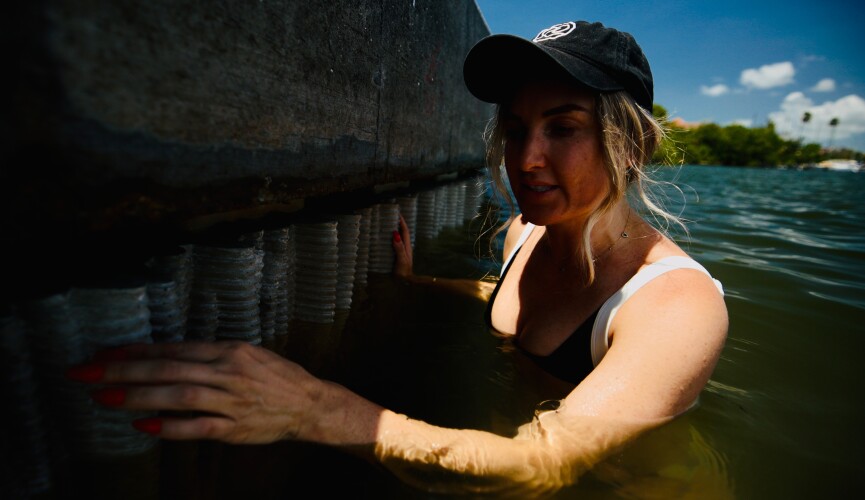LONGBOAT KEY, Fla. — A seawall at Bayfront Park on Longboat Key is getting a makeover with the goal of creating a new home for oysters, crabs, starfish, and other marine life following the installation of “living tiles.”
Watch full report from Michael Paluska
The project, led by Miami-based Kind Designs, marks the company’s first work on Florida’s West coast — and the first installation for a government client.
“I’m seeing the living tiles in the water for the first time. They’re amazing,” Anya Freeman, founder and CEO of KindDesigns said. “Hearing that there’s already crabs and starfish living on the seawalls is extremely exciting.”
In April, Tampa Bay 28 reporter Michael Paluska recently traveled to Miami to see how the living seawalls and tiles are constructed.
The 3D-printed concrete tiles are designed to mimic natural mangrove roots, with textured surfaces and built-in cavities that provide shelter for small organisms.
“This is our very first time doing living tiles, which you can attach to an existing seawall,” Freeman said. “We were able to make custom tiles to transform the existing vinyl wall into a living seawall without having to replace it.”
Scientists say the innovation could help restore some of the habitat lost when traditional seawalls replaced mangroves and estuaries.
“Back even 100 years ago, this area was mangrove forest,” Ryan Gandy, Science and Restoration Manager for the Sarasota Bay Estuary Program said. “When sea walls went up so we could build on it, a lot of that habitat went away.”
Older concrete walls sometimes developed marine growth on their own, Gandy explained, but newer vinyl or plastic walls are harder for organisms to colonize.
“What the tiles do is provide a nice, pH-balanced concrete,” he said. “Oysters, barnacles, sponges, even algae will start growing on it, and that creates structure for crabs, shrimp, and oysters.”
The first signs of life may appear within weeks.
“You’ll start seeing algae and films within several weeks, barnacles within months, and oysters after about 18 months,” Gandy said. “We’ll be photo-documenting specific areas to watch the changes over time.”
Freeman said scaling projects like this is critical as Florida confronts rising seas. “Florida is the first state — the first place in the world — to face this problem of flooding and rising sea levels at scale,” she said. “We’re either going to be an example to the rest of the world or a lesson.”
Freeman told Paluska that there are 507 cities globally at risk from flooding.
“The infrastructure many cities have now is not only bad for the environment, it’s also cost-prohibitive,” Freeman said. “We are eager to scale it, democratize it, and provide an affordable solution to every person at risk.”
Gandy told Paluska that during the 1700s through 1800s, Sarasota Bay was so wild that fishermen from Cuba made the journey to the area to “catch mullet, drum, turtles, trout, and mackerel to ship back to Cuba. In this early settlement period, before large-scale estuary changes, the fishers from Cuba established long-term fish camps or ranchers on the shores of both Sarasota and Tampa Bay,” Gandy said. “The reason for this was that the West coast of Florida was still a wild place with extensive mangrove forests, dense wetlands, and abundant seagrass beds, resulting in high natural productivity of the fish and wildlife.”
Gandy said that with urbanization and continued expansion of our human footprint, the hardened shorelines will never be able to replicate the full complexity of the mangrove forests that once lined Florida’s coast. But, Gandy said, they help restore a portion of lost habitat. “It doesn’t replace the original ecosystem that was here, but it helps mitigate for losing that little bit that was on the seawalls before,” he said. “That can really help in our local coastal environment.”
Sarasota Bay’s health is shaped by a mix of pressures — from pollution to extreme weather events. Earlier this year, the Sarasota Bay Estuary Program team took Paluska on the water to discuss how reopening Midnight Pass could affect the bay following Hurricanes Helene and Milton.
Share Your Story with Michael

A lot goes into the price of paradise and Michael Paluska focuses on every aspect. From the job market and housing to how Florida’s growth impacts our state’s wildlife. Send Michael tips to keep these important conversations going.
.

'What’s the point?' Nearly 90% of drivers who appeal school bus camera tickets lose
FL’s controversial school bus cameras are fueling new frustrations for drivers who believe the appeals process is one-sided. Investigative Reporter Katie LaGrone continues her coverage.





